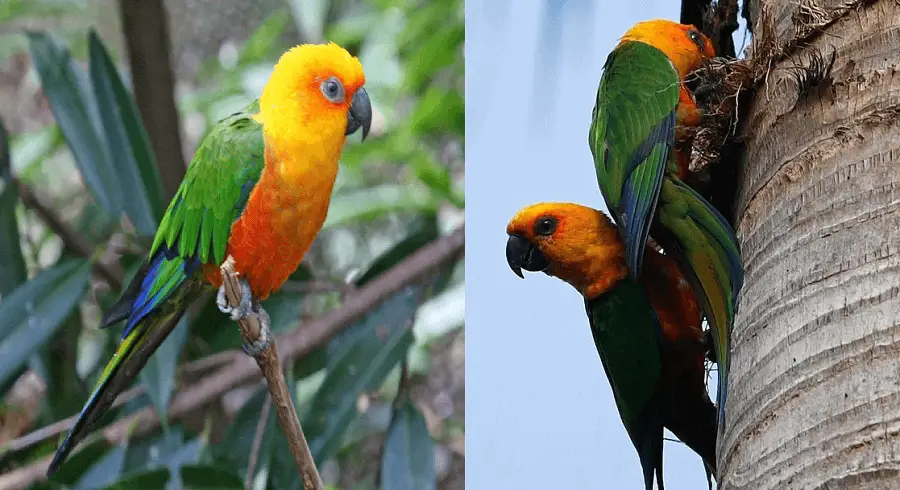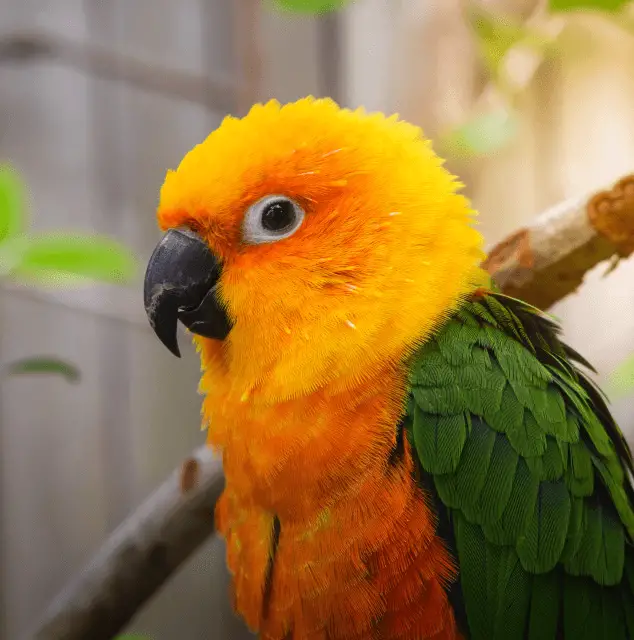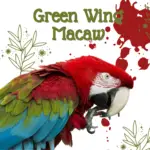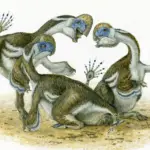
The Jenday Conure or Jendaya Parakeet( Aratinga jandaya ) is a species of parrot from the genus of the Macaw Parakeets ( Aratinga ). It is native to Brazil.
Features
The Jenday Conure measures between 26 and 36cm for a mass varying from 100 to 130g. She has beautiful orange-yellow colors over a large part of her body apart from her back which is bluish-green.
Its head is yellow with sometimes, around the eye, orange-yellow and a little red, and its belly is orange-yellow. Its back and the top of its wings are green in color while its primary flight feathers are blue and black.
Its paws are gray with black nails. Its beak is black. The iris, brown, is surrounded by a very thin white eye ring. The adults do not have sexual dimorphism, on the other hand, the young at the exit of the nest can be differentiated. Indeed, the males have a completely yellow head while the females also have some green feathers.
The Jenday Conure/ Jendaya Parakeet reaches a size of 30 centimeters. The head and throat are yellow. The upper breast is orange. The front forehead and often the eye area are red. The abdomen, flanks, and underwing coverts are orange-red. The edges of the green lower back feathers are red.
The outer flags of the hand wings, the hand covers, and the arm wings are blue. The top of the tail is olive green with blue tips, the underside of the tail and the hand and arm wings are black.
A black eye ring runs around the whitish iris. The beak is black, the feet are gray. The heads of juvenile birds are light yellow with scattered green feathers. The iris is dark.

Spread
The distribution area extends in northeastern Brazil from northern Goiás via Piauí and Maranhão to Ceará , Pernambuco and Alagoas .
Habitat
Two Jendaya parakeets (center) and one sun parakeet in human care
The Jendaya parakeet inhabits the tree-covered Caatinga steppe, cleared areas, and the edge areas of rainforests and coconut palm plantations.
Playful Jenday Conure
SOURCE:Kimberly Bowman
Way of life
Little research has been done on its way of life in the wild. It can usually be seen singly, in pairs, and in small flocks of 10 to 15 birds. He’s not shy and his screeching makes him very noticeable. Its flight is nimble and direct. It often flies close to the ground and suddenly changes direction.
Its reputation is particularly high-pitched during the flight. The breeding season is probably from October to January. A nest was discovered in a tall, rotten tree. The eggs are 28.4 × 22.6 mm in size. The diet is vegetarian and consists of seeds, berries, fruits, and corn.
Status
The population size of the Jendaya Parakeet is unknown. It is quite common, but the size of the subpopulations is inconsistent. Although the habitat is expanding due to the clearing of the forest, the population is declining in some areas due to the illegal animal trade. The IUCN classifies it as not at risk ( least concern ).
Reign. Animalia.
Branch. Chordata.
Sub-branch. Vertebrata.
Class. Aves.
Order. Psittaciformes.
Family. Psittacidae.
Kind. Aratinga.
Latin name. Aratinga jandaya.
Meet And Greet: Ecuador the Jenday Conure
SOURCE: AnimalWonders Montana
Jenday Conure Natural habitat
It is found in the northeast of Brazil
Jenday conure Captivity
An aviary 3m long by 2m wide and 2m high attached to a shelter 1m long by 2m wide and 2m high is necessary for a pair of Jenday Conure.
She will ask for a nesting box all year round because they will sleep there at night.
Aratinga Jenday Conure Longevity
Jenday Conure lifespan:
They can live for about 25 years.
Jenday Conure Behavior
They are very good sailboats and real destroyers. They are very friendly and playful EAM birds.
They are quite dynamic and love to shred fresh branches, hang from the ceiling, or search the ground.
They are very noisy and have a very loud and very piercing cry, often little appreciated.
Jenday Conure Food
In captivity, a mixture of seeds for large parakeets mixed with seeds for small parrots, sprouts, fruits, vegetables, and some vitamins will suit him perfectly.
In their natural environment, its conures will eat a large number of wild fruits and seeds, but also those of cultures which can create great damage.
Jenday Conure vs sun conure
SOURCE: Saarim’s Birdzotic
Jenday Conure Reproduction
The sexual maturity of this species begins around the age of 2 years. They breed from March to July. The nest must have the following dimensions, 60cm high for 30cm in diameter, it will be placed high, and will have a flight hole 8 cm in diameter.
Jenday Conure size
The base should be composed of ¾ peat and ¼ wood chips 15 cm thick. The female will lay between 3 to 6 eggs which she will incubate alone, while the male keeps watching, for about 24 days.
The young will leave the nest after 7 weeks but the parents will continue to feed them for another 2 to 3 weeks. Several broods per year may be feasible.
Jenday Conure Status in the Natural State
Jenday Conure species is classified as Least Concern on the IUCN Red Liste.
Do Jenday conures talk?
Jenday conures are not known for their talking ability.
Are Jenday conures good pets?
jenday conures make good pets for owners and parrot lovers who can spend a lot of time socializing with them
What’s the difference between sun conure and Jenday Conure?
Jenday conure is one of the medium-sized conures TheJenday conure is the same size as the sun conure but the sun conure parakeet body is primarily green with a yellow head and bright orange.
Read more about conure:




















